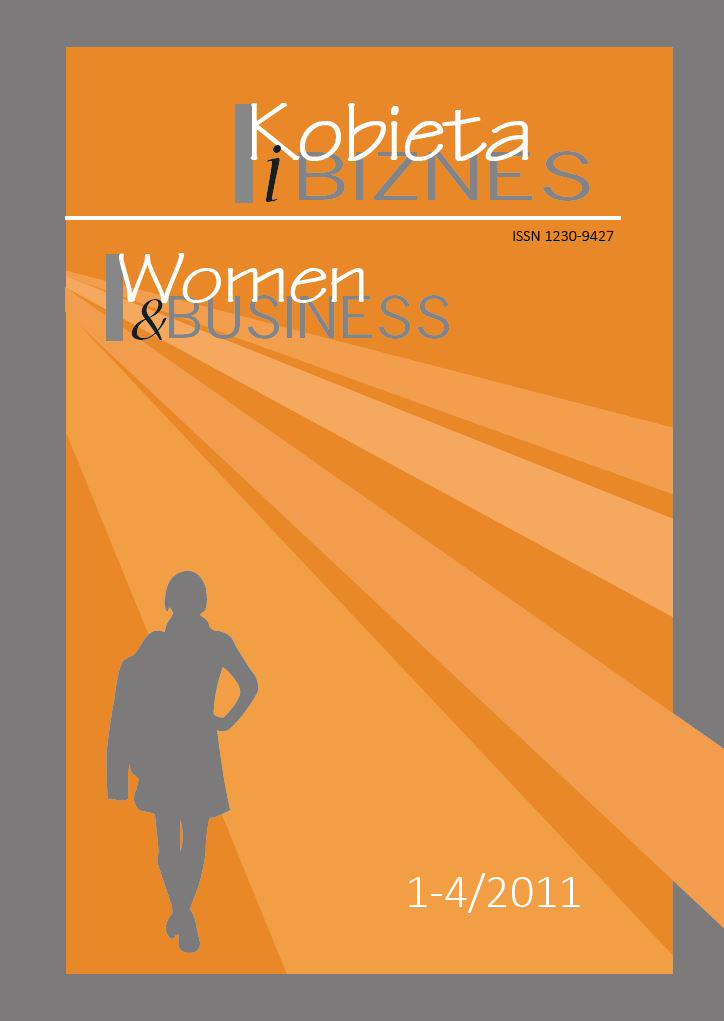Marketing skierowany do kobiet
##plugins.themes.bootstrap3.article.main##
Abstrakt
Kobiety podejmują decyzje, w tym decyzje zakupowe, inaczej niż mężczyźni. To efekt emocjonalnych i społecznych różnic między płciami. Akronim "Czujesz" (Człowiek, Zbawicielka, Uporządkowanie, Jednocześnie, Empatia, Społeczność, Zmysłowo) opisuje syntetycznie kobiecy kod komunikacji: wartości emocjonalne, wokół których skonstruowanie przekazu marketingowego do kobiet może zwiększyć jego skuteczność. Różnicowanie komunikatu marketingowego na adresowany do kobiet lub do mężczyzn, albo wzbogacanie istniejącego komunikatu o elementy, które wzmocnią przekaz do klientek to strategie, które mogą być w dzisiejszych czasach skuteczne. Sprzedaż produktów kobietom wymaga przygotowania i otwarcia na dialog, ale przynosi wymierne korzyści w postaci zwiększenia obrotów i zyskania lojalnej, promującej markę konsumentki.
##plugins.themes.bootstrap3.article.details##
Autor (Autorzy) artykułu oświadcza, że przesłane opracowanie nie narusza praw autorskich osób trzecich. Wyraża zgodę na poddanie artykułu procedurze recenzji oraz dokonanie zmian redakcyjnych. Przenosi nieodpłatnie na Oficynę Wydawniczą SGH autorskie prawa majątkowe do utworu na polach eksploatacji wymienionych w art. 50 Ustawy z dnia 4 lutego 1994 r. o prawie autorskim i prawach pokrewnych – pod warunkiem, że praca została zaakceptowana do publikacji i opublikowana.
Oficyna Wydawnicza SGH posiada autorskie prawa majątkowe do wszystkich treści czasopisma. Zamieszczenie tekstu artykuły w repozytorium, na stronie domowej autora lub na innej stronie jest dozwolone o ile nie wiąże się z pozyskiwaniem korzyści majątkowych, a tekst wyposażony będzie w informacje źródłowe (w tym również tytuł, rok, numer i adres internetowy czasopisma).
Osoby zainteresowane komercyjnym wykorzystaniem zawartości czasopisma proszone są o kontakt z Redakcją.
Autor zgadza się na dalsze udostępnianie pracy wg wymagań licencji CC-BY-NC
Bibliografia
2. Barletta M., Marketing skierowany do kobiet, CeDeWu, Warszawa 2008.
3. Cunningham J., P. Roberts, Inside Her Pretty Little Head, Marshall Cavendish Business, London 2006.
4. Female Power, "The Economist" 2 January 2010.
5. Fischer H., Pierwsza płeć. Jak wrodzone talenty kobiet zmienią nasz świat, Wydawnictwo Jacek Santorski & Co, Warszawa 2003.
6. Guyette J., La Femme: a fancy and feminine statement of the chauvinist '50s, Aftermarket Business, January 2004.
7. Holson L.M., Smartphones Now Ringing for Woman, "New York Times", 10 June 2008.
8. Howard L., The International Dodge La Femme Website and Registry, www.dodgelafemme.com, July 2003.
9. Kimura D., Are men's and women's brains really different? "Canadian Psychology" 1987, No. 28.
10. Lawson S., Women Hold Up Half the Sky, "Global Economics Paper" No. 164, 4 March 2008.
11. Lewis M., J.M. Haviland-Jones (red.), Psychologia emocji, Gdańskie Wydawnictwo Psychologiczne, Gdańsk 2005.
12. Pawlikowska K., M. Poleszak, CZUJESZ?... czyli o komunikacji marketingowej i sprzedaży skierowanej do kobiet, CeDeWu, Warszawa 2011.
13. Pease A.B., Dlaczego mężczyźni nie słuchają a kobiety nie umieją czytać map, Dom Wydawniczy REBIS, Poznań 2004.
14. Pinker S., Paradoks płci, Zobacz jak różnica płci wpływa na każdy aspekt współczesnego życia, Wydawnictwo Czarna Owca, Warszawa 2009.
15. Peters T., Essentials, "Trends" DK Publishing, Nowy Jork 2005.
16. Popcorn F., Marigold L, Eveolution: The Eight Truths of Marketing to Women, Hyperion Nowy Jork 2000.
17. Prescott J.W., Early somatosensory deprivation as an ontogenetic process in the abnormal development of brain and behavior, Karger, Basel 1971.
18. Silverstein M.J., K. Sayre, Women Want More, Boston Consulting Group, New York 2009.
19. The Power of the Purse: Gender Equality and Middle-Class Spending, Goldman Sachs, Global Market Institute, 5 August 2009.
20. UK Office for National Statistics, Family Expenditure Survey, 2001, http://www.statistics.gov.uk/STATBASE/Source.asp? vlnk=1385&More=Y.
21. Underhill P., What Women Want, Simon & Schuster, New York 2010.
22. Who Buys What: Identifying International Spending Patterns, Euromonitor, Fabruary 2007.
23. Witelson S., I. Glezer, D.L. Kigar, Women Have Greater Density of Neurons in Posterior Temporal Cortex, "Journal of Neuroscience" 1995, No. 15.
24. Wojcieszke B.(red.), Kobiety i mężczyźni: odmienne spojrzenia na różnice, Gdańskie Wydawnictwo Psychologiczne, Gdańsk 2002.
25. Yunus M., Przedsiębiorstwo społeczne, kapitalizm dla ludzi, ConCorda, Warszawa 2011.

